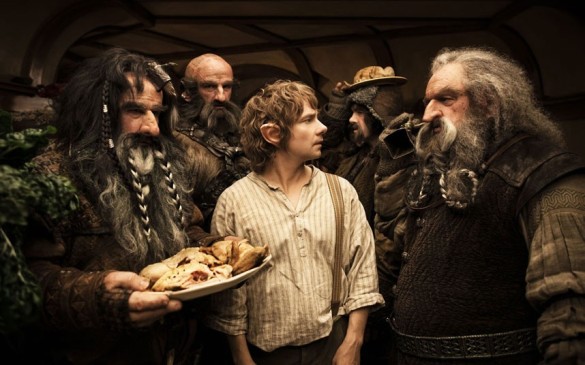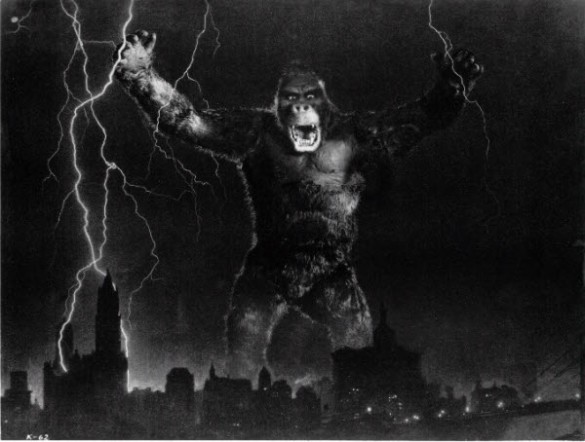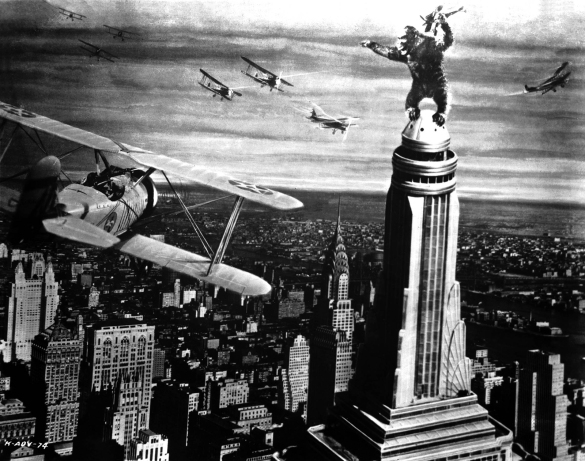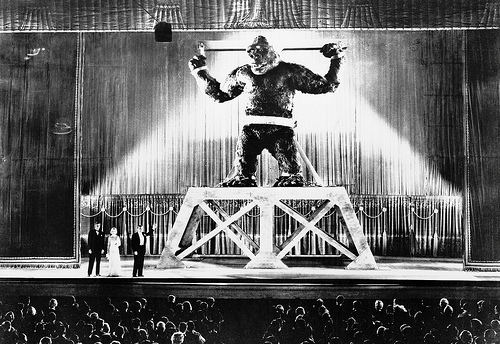We were all so stoked to love this one too, weren’t we? And I went with three people who had never read the books or seen any of the movies. Two of them didn’t even speak English.
Here’s the thing, I don’t think The Hobbit: An Unexpected Journey (2012) is a bad movie, but The Lord of the Rings trilogy was a tough act to follow. There are a few improvements over Peter Jackson’s earlier Tolkien efforts, but there’s quite a bit that seems to be huge steps backward and I’d venture to say that most of what is wrong with The Hobbit is that it is one book as three movies—and three post-Frighteners Peter Jackson length movies at that.
Let’s take it easy. There are a few things that work really well for The Hobbit so far. One is its levity. Some might see it as a detriment, but that it’s tonally a much lighter tale makes much of the action feel a little fresher. Unfortunately too much buoyancy can make the movie feel somewhat flippant compared to the previous films. The fact of the matter is Tolkien’s first foray into Middle-Earth was written to be a children’s story, but movie audiences are getting a reverse ordered experience…and it doesn’t exactly work that way.
The Lord of the Rings seemed to be structured as a serious story with serious stakes and a few humorous touches and some whimsical comic relief characters—but who could still suffer through terrifying ordeals. There’s a lot of seriousness and foreboding. The Hobbit is much more lighthearted with maybe one sort-of heavy character, Thorin Oakenshield (Richard Armitage). There’s a dumb vendetta an albino Captain Hook orc has against Thorin, but it never comes off as anything more than a tag-on. You can tell Thorin is supposed to be our Aragorn character, but it feels forced. Even Gandalf is a lot more light this time around (which I actually like a bit better than the overly serious Gandalf the White). I like an imperfect mischievous Gandalf.
What’s Better:
Anyway, let’s just be simple about this thing. What do I think is better about The Hobbit? Well, Gandalf’s a lot more fun but I’d say it’s a tie because his function is a little different in this series than in Lord of the Rings. Yeah, Ian McKellan still rocks, but maybe not harder.
The effects to bring Gollum to life look better for sure and he is treated just as he should be in this film: he is not an all important cog in the wheel of destiny yet. He is a chance meeting. That is what makes him so interesting. We don’t know much about him when he is first introduced. The Gollum scene is such a treat for fans of the book and fans of special effects that it might be worth seeing the whole movie just for that. Once again Andy Serkis’s performance is solid through and through.
When it comes to Bilbo (Martin Freeman) you do have to take humor into account. Bilbo is a much more relateable character than Frodo was, I think. I like Elijah Wood but he was a little hard to relate to as Frodo. He was so dour, starry eyed, and spacey that a quirky, stammering unlikely hero such as Freeman’s Bilbo is a very welcome change of pace. He feels more like how hobbits are supposed to be. Hobbit’s are supposed be simple isolationist folks who like the familiar.
I think that about covers the improvements. Bilbo’s levity, Gollum’s deranged game of riddles, and Gandalf ties with himself. That means everything else falls short of The Lord of the Rings.
What’s worse:
Character dynamics are lacking.
The dwarfs are okay, but they are essentially a small army of Merry and Pippins. Thorin is too heavy and stands out to almost comic effect. He’s like Oliver Reed sweatily bellowing lines at Muppets. The rest of the dwarfs are hard to keep straight. There’s so many and all their names rhyme and many are not given more than a syllable to utter onscreen that it’s hard to see them as anything but a band of bearded buffoons. Balin (Ken Stott) stands alone as the most interesting of the dwarfs. He’s old and has seen it all, but he wears his experiences gracefully. He reminded me a little of Takashi Shimura’s character in Seven Samurai.
Then there’s the lean, beardless ‘hot’ dwarf for the ladies. It comes off as a little goofy when the rest of his company is so silly, warped, and grotesque looking.
I miss John Rhys-Davies as Gimli.
The other minor characters aren’t bad, but I feel like we need either more or less of them. Radagast the Brown is a perfect example. Played by ex-Dr. Who, Sylvester McCoy, he’s a lovable, quirky fellow but he comes out of nowhere and just sort of disappears. He’s almost too quirky. I understand he will probably return in the other two movies, but something still feels underdone. Either explain more or give me less and let my imagination fill in the blanks.
Elrond, Galadriel, Saruman, Frodo, and maybe a few others are tossed into the shuffle but the energy is not the same. It feels like fan service more than story, even if they did appear in the book.
The special effects are incredible, but there’s so much of them that many of the battles feel like cartoons, which sucks out a lot of the suspense and the sense of danger you need for this sort of thing.
The conflicts are more isolated and the action is episodic. Halfway through the film it just struck me that we will just be watching these characters run away from different monsters, take a false breath, and then run again. Run-away-from-the-special-effects scenes can work if they develop character, feed the plot, or are not the whole movie. It just gets tedious after awhile and the bottomless bag of Deus ex machinas becomes ridiculous, again sucking suspense out of the excitement.
I did not see the movie in 48 fps and I hesitate to attempt it. I haven’t heard a single positive report about it yet. If it’s anything like the display TVs at Best Buy where everything looks feathery and the motion blur is gone then I’d rather not. It just looks unnatural and distractingly unreal. They say it’s more real, but it just looks weird and fake to me.
The biggest problem with The Hobbit is the three movie stretch. This story does not have the same high stakes or the same rich emotional core or the same balance of drama and comedy that The Lord of the Rings had. I think this stuff wouldn’t bother me if this movie had been made first instead. In addition, Lord of the Rings is a solidly dense set of three books, while The Hobbit is just one. Each Rings film can end on a cliffhanger and still feel satisfying and complete its own story arc. As a film told in three parts, The Hobbit feels like 1/3 of a single story arc and thus is not so satisfying as it is frustrating.
As with Jackson’s King Kong remake he has once again managed to take a simple, efficient story and stretch it and bloat it to unnaturally long durations. But I wonder whether all the added time has brought us any closer to these characters.
Ultimately:
What is the verdict? The Hobbit ain’t perfect, but it’s not bad. Lord of the Rings ain’t perfect neither, but it was a whole lot closer. I was honestly entertained the whole time. I admired the spectacles. You’d have to have an army of mad geniuses to pull off half the razzle-dazzle tricks this movie goes for. The trouble is sometimes mad geniuses are misguided. Because it’s broken up the way it is it just strikes me as incomplete…because it us. Shoulda been one movie. Maybe two. There just isn’t enough material here for three.
All that being said, I liked the monsters and seeing all the cool scenery. And Bilbo is good too. It’s still Middle-Earth, but it most certainly is not the same bold and rich story we might have hoped for. It’s entertaining (if a bit repetitive), just not as substantive.



















